Home Story Glances with Wolves
Glances with Wolves
Feature type Story
Read time 6 min read
Published Jun 16, 2021
Author Ester de Roij
Photographer Ester de Roij
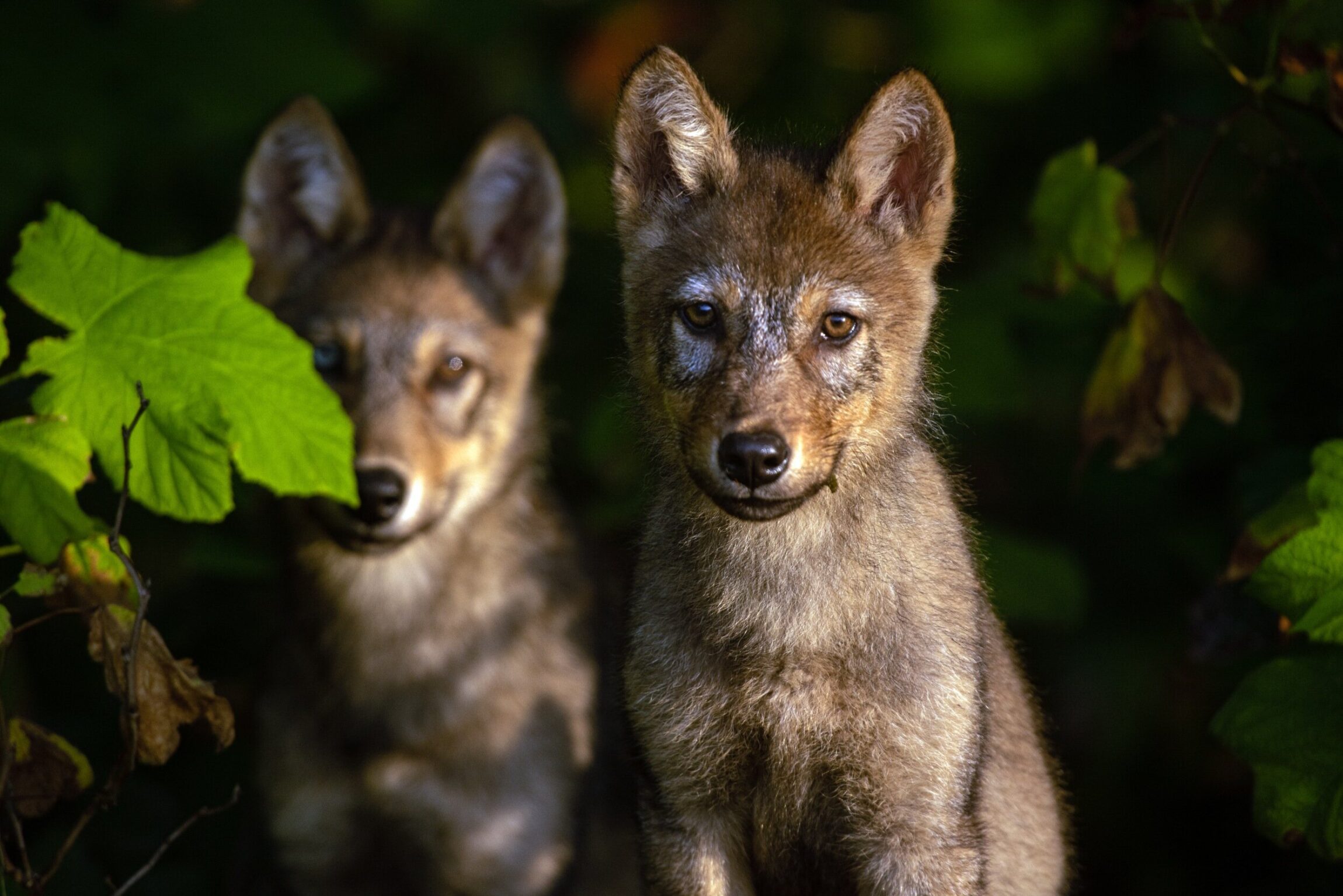
Seeing coastal wolves in British Columbia – let alone photographing them – is a dream for most avid naturalists on Canada’s Pacific coast. They can be considered more of a mystery in the Great Bear Rainforest than spirit bears: catching a glimpse of them is far more difficult and unpredictable. If you manage it, they’re gone in a blink of the eye like ghosts of the forest.
Naturally, they were high up on my own list. I had only seen them twice in my 18 months on and off the coast. If it wasn’t for some average photographic evidence, no one would have believed me. A friend of mine who leads bear viewing tours had told me last year about a spot where she thought there might be a den, and this year I was thinking of placing some camera traps around the area, just as an experiment. I contacted my friend and she told me they hadn’t seen any sign of wolves there, but there was another spot where there were regular sighting reports. I asked her whether it was worth me going and camping out; her response was a definite yes.
Before I knew it I’d cleared a week in my schedule, stocked up on camping gear, rehydrated food, and a bear canister. Wolves and people have clashed on multiple occasions around the coast, usually as a result of careless behaviour on the part of the campers – but it’s the wolves that get penalised. The safest way to camp is to bring food with as little odour as possible, and keep it locked in a bear canister all the time. Wolves can get into pretty much anything, so you are advised to suspend the canister from a tree so that it is out of reach of any big carnivores.
I took a water taxi over to a remote beach and had a little scout around. The beach was fairly short and bordered by jagged rocks on either side, backing up into the forest. I hadn’t exactly thought through how I was going to find these elusive creatures, and I figured there’s not much I could do until I got there. On my beach though, there were many wolf prints in the sand and mud: already a good sign.
I went about setting up my tent. Halfway through unfolding the flysheet, I heard a howl. When I turned around I saw something white running across the rocks in the distance. A wolf! I grabbed my camera equipment and went after it. The terrain was very rough, and the high tide didn’t do me any favours; I was no match for a wolf in this country. I gave up after about an hour and went back to set up camp.
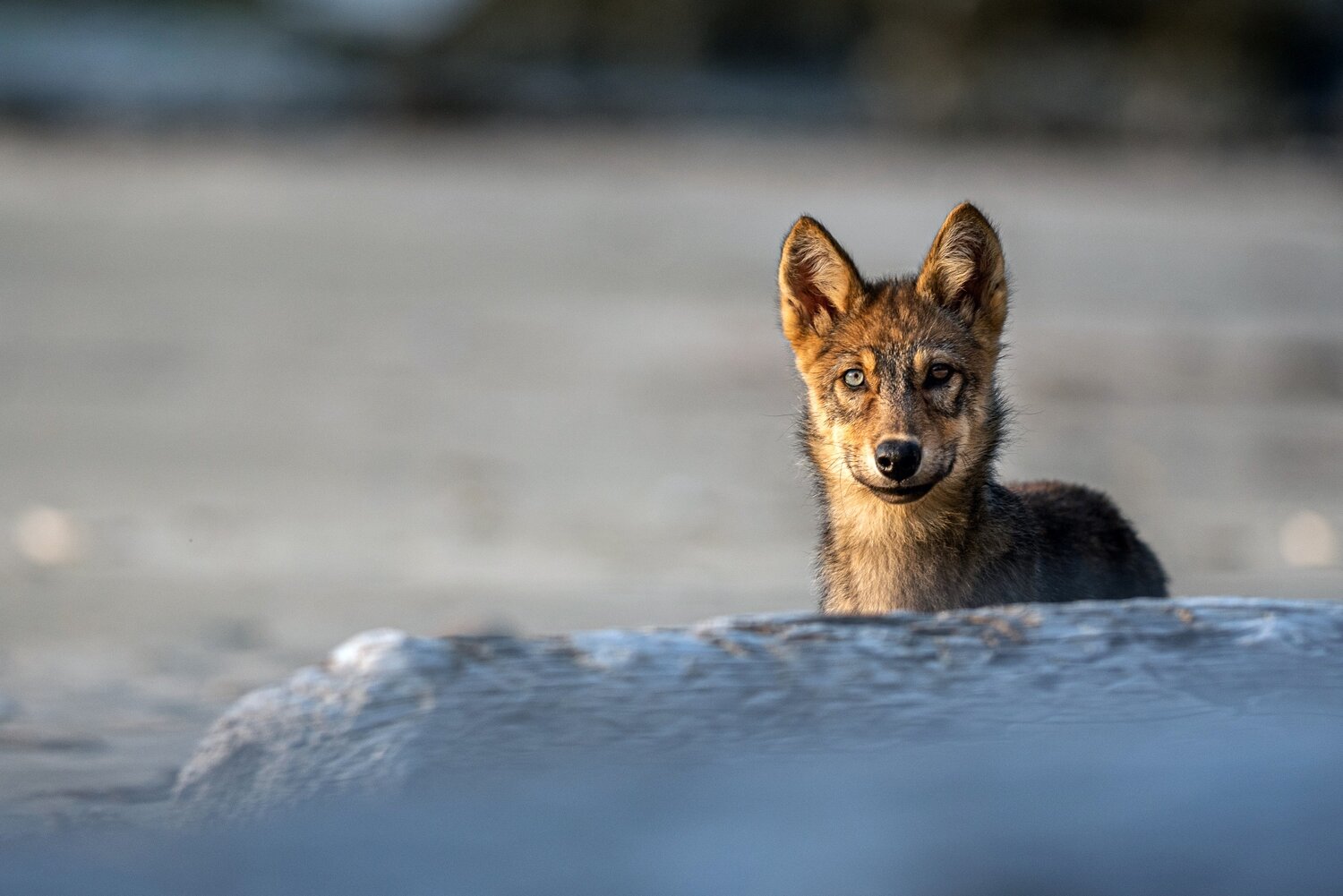
The wolf cubs only hung around my camp for a minute or two, but it felt like an eternity. Here, I was truly in the presence of wild nature
A short time later, I looked out of my tent at the spot where I had seen the wolf earlier, but saw nothing. After a while I peeked out again. Even though there was nothing at the far corner of the island, I saw what I first thought was a juvenile wolf lying on a log at the back of the beach.
I quickly grabbed my camera and only managed a few blurry shots before it decided to get up and walk into the forest, trailed by another three small wolves that had been resting motionlessly around it. I patiently waited inside my tent hoping they would come out again. Sure enough, fifteen minutes later out they came, a bit further away, trotting onto the beach as if they owned the place, playing and digging in the sand in a very relaxed manner.
One was lying down facing me, keeping a close eye. Suddenly they all went back into the forest again. I was on high alert and a minute or two later I head branches breaking right behind my tent. I leaned out carefully, camera in hand, until I saw two little faces. They had expressions filled with curiosity, playfulness and a little caution. They thought about coming out for a second or two before continuing around my tent in the forest. This time, I could anticipate where they would appear.
I stayed in my tent using it as a hide as all four pups appeared in front of me, each egging the other on to get as close as they felt comfortable to do. At no point was I scared – adrenaline and incredulity were rushing through me – but I did make sure I had bear spray ready to use at arms’ reach. At this moment, I realised one of them had this gorgeous single blue eye, which I’d not seen before in wild wolves.
They only hung around for a minute or two, but it felt like an eternity. Here, I was truly in the presence of wild nature.
When they’d finally satisfied their curiosity, they went back into the forest going the way they’d come, and popped out again behind my tent. This time they found the courage to come out and walk along the logs at the back of the beach quickly making their way back to their play spot a short distance from my tent.
Once they were out of reach of my camera lens, I finally heard myself breathe out; I was smiling from ear to ear. Not only had this just happened on the first night I was out here, but a wolf had made it to within five metres of me, and all of this in the most beautiful golden light. The magic of the moment was certainly not lost on me.
That evening, at nightfall I caught sight of one of the adults running past my tent, and the next morning after the fog had rolled in I saw an adult running past with all four pups in tow before they disappeared out of line of sight and started to howl for a few minutes. They never approached me again after that first night, but came out to play at their safe distance, keeping an ever-watchful eye on me. Over the next few days, I only saw the adults when I least expected them, and after about four days the pack relocated, and I didn’t see the pups again.
Coastal island wolves have always been recognised as a distinct form of wolf from the more common timber wolf by First Nations groups. Wolves had to repopulate Vancouver Island as recently as the 1970s, where they were the subject of hunting and habitat loss. Coastal island wolves are genetically distinct from interior wolves; a change that has been driven by available food resources more than location.
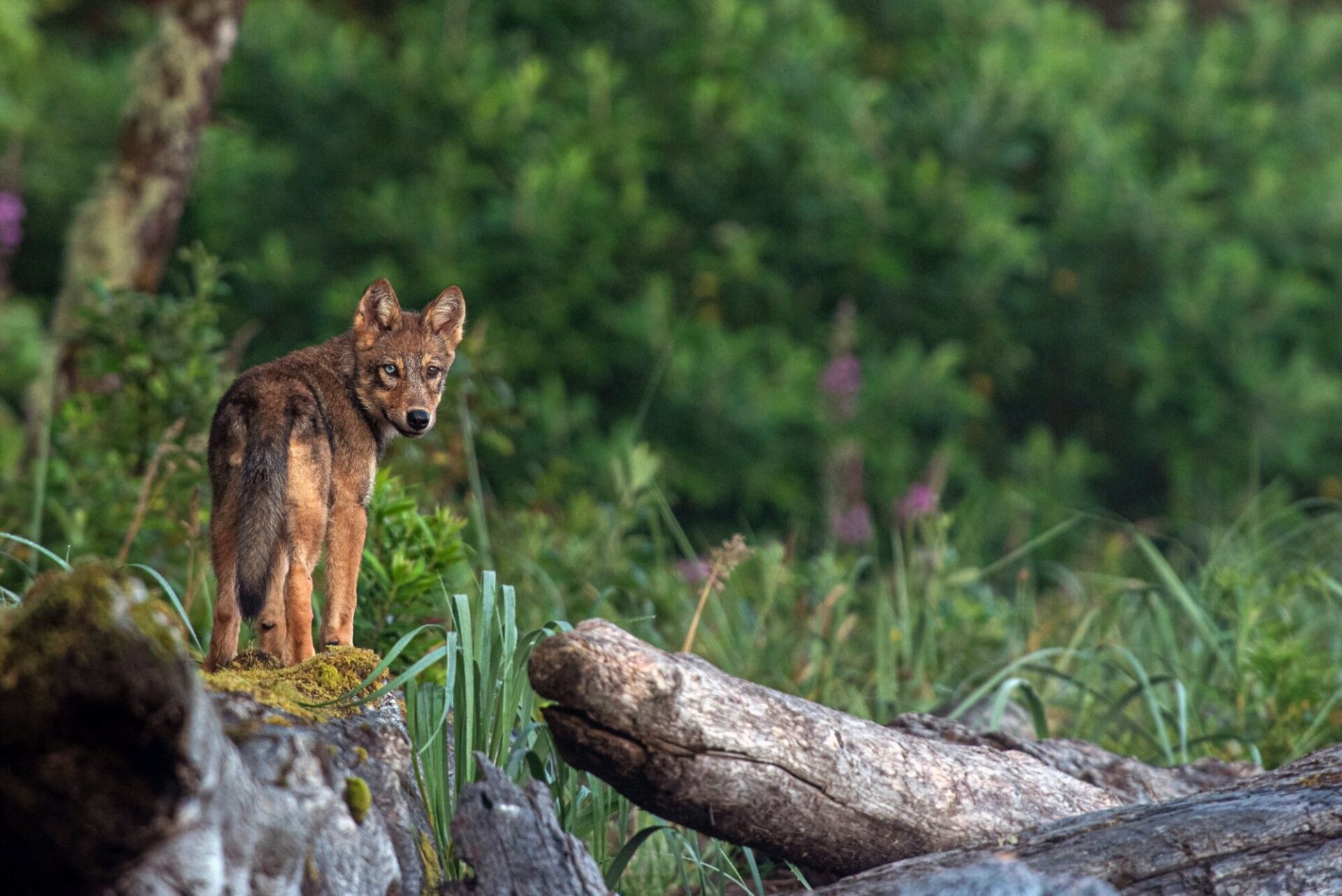
Coastal wolves rely on marine life for up to 85% of their diet, compared to 30% of interior wolves. Even within the coastal wolf form, there are considered to be two types: mainland coastal wolves, and coastal island wolves. These groups are again separated by their diet – mainland coastal wolves supplement their diet with things like black-tailed deer. For coastal island wolves – the wolves in these photos – 25% of their diet consists of salmon followed by barnacles, herring eggs, seal carcasses and whatever else they can catch. I found some fresh wolf scat that had some black fur in it. This may have been bear, and recently some lucky tourists were treated to seeing one of these very wolves drag a deer out of the water. They will scavenge on whatever they get their hands on if it’s more nutritious than barnacles.
Wolves and dogs are known to be able to produce fertile offspring. Male wolves have seasonal sperm production to coincide with females coming into oestrus between January and April, whereas male domestic dogs produce sperm all year meaning that they are always readily able to mate with female wolves. The only information known about the wolves I went looking for was that there was a pair of female wolves on that part of Vancouver island. When I encountered the pup with the blue eye, I knew that these were most likely born to a husky dog, with the pack led by two female wolves.
Coastal wolves can swim more than seven miles, and are very comfortable in the water. They move easily from island to island, meaning they will come into contact with whatever is around them. If there are people with dogs in the region, the odds of a female wolf encountering a male wolf is smaller than the odds of a female wolf encountering a male dog who is fertile all the time. From talking to locals, I have understood that the particular case of the blue-eyed wolf in my photos most likely happened by accident, but I also understand that it is currently popular to get a dog purposefully bred with a percentage of wolf genes.
Wolves have very specific behavioural and physiological adaptations to survive in the wild, and to avoid human predation. The more these adaptations get filtered out through breeding with domestic dogs, the less certain the future of the wolf looks in our turbulent climate with unreliable resources and extra human pressures. 2019 was the worst salmon year on record in Canada, and that means that a quarter of the annual intake of these wolves is under serious threat.
To survive, wolves need to adapt to their environment, and having their natural mechanisms for this responsiveness filtered out by humans is the last thing they need. In my rare glances of these wolves, both their strength as wild animals and their fragility as a species became abundantly clear.
Don’t miss a single adventure
Sign up to our free newsletter and get a weekly BASE hit to your inbox
You might also like
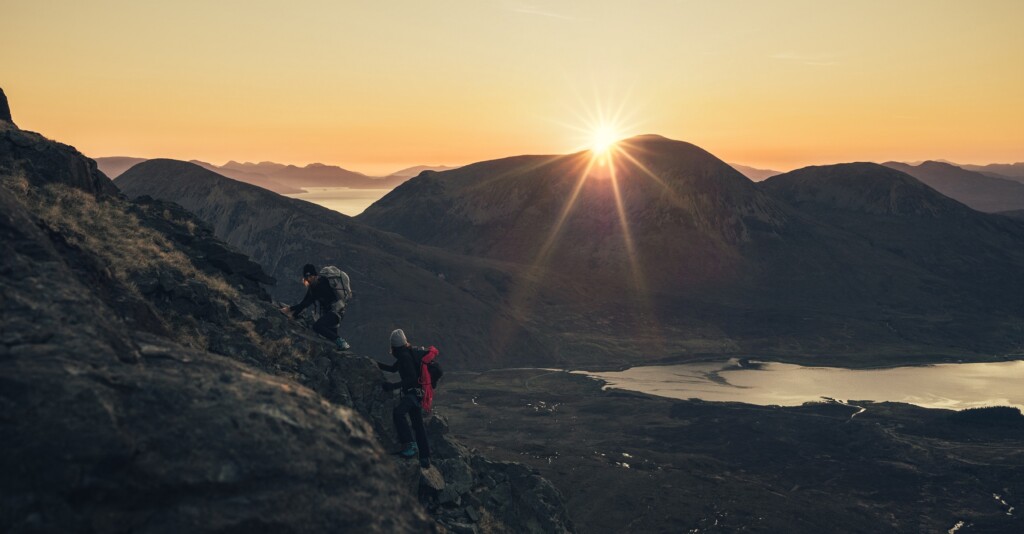
Story • Kieran Creevy • Jun 16, 2023
Scrambling Before Scran on Scotland’s Misty Isle
Sun-drenched ridge lines with expedition chef Kieran Creevy on the Isle of Skye
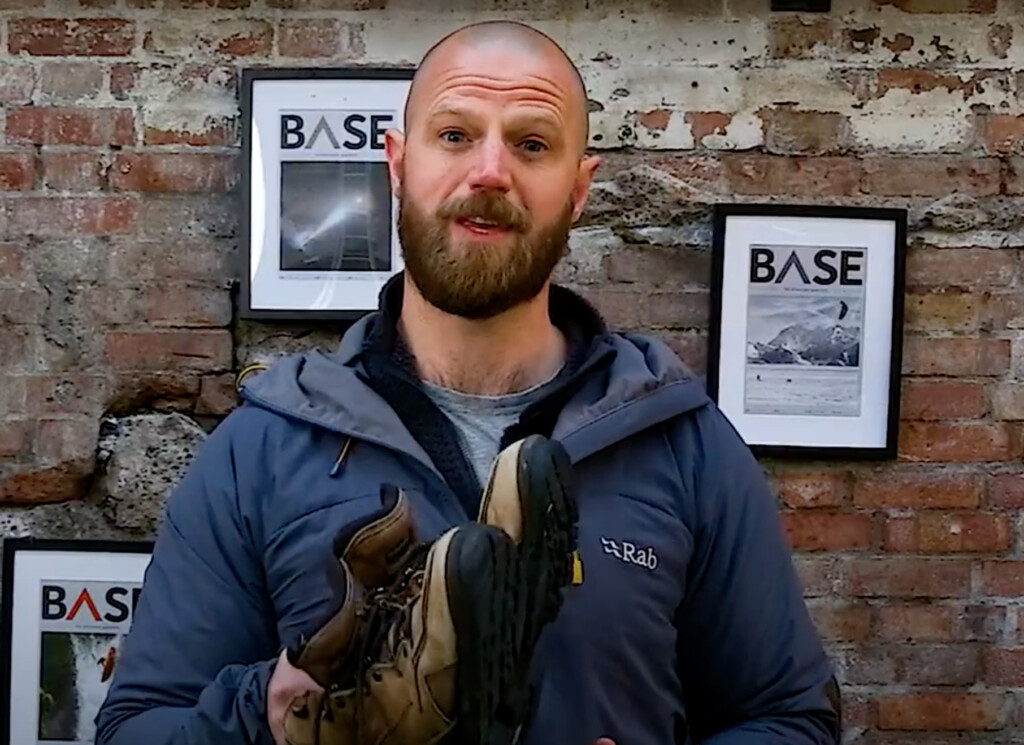
Video • BASE editorial team • Jun 02, 2023
How To Clean And Care For Hiking Boots
Our top five tips to give your hiking boots a 'glow up'
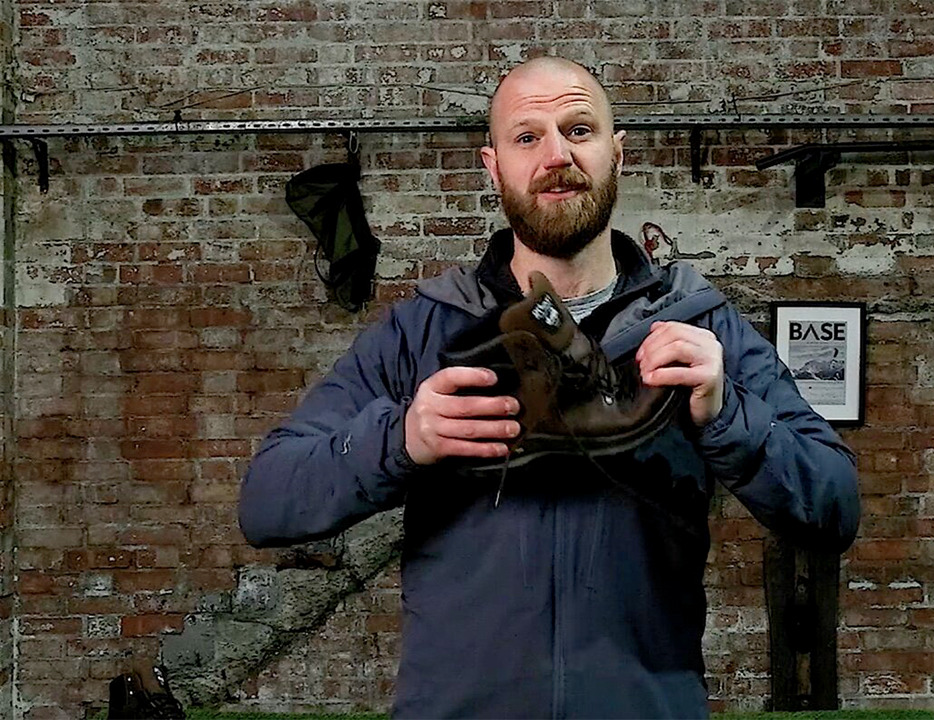
Video • BASE editorial team • Mar 30, 2023
How To Break In Leather Walking Boots
5 fast hacks for breaking in your boots, beating the blisters and reducing the ankle rub
